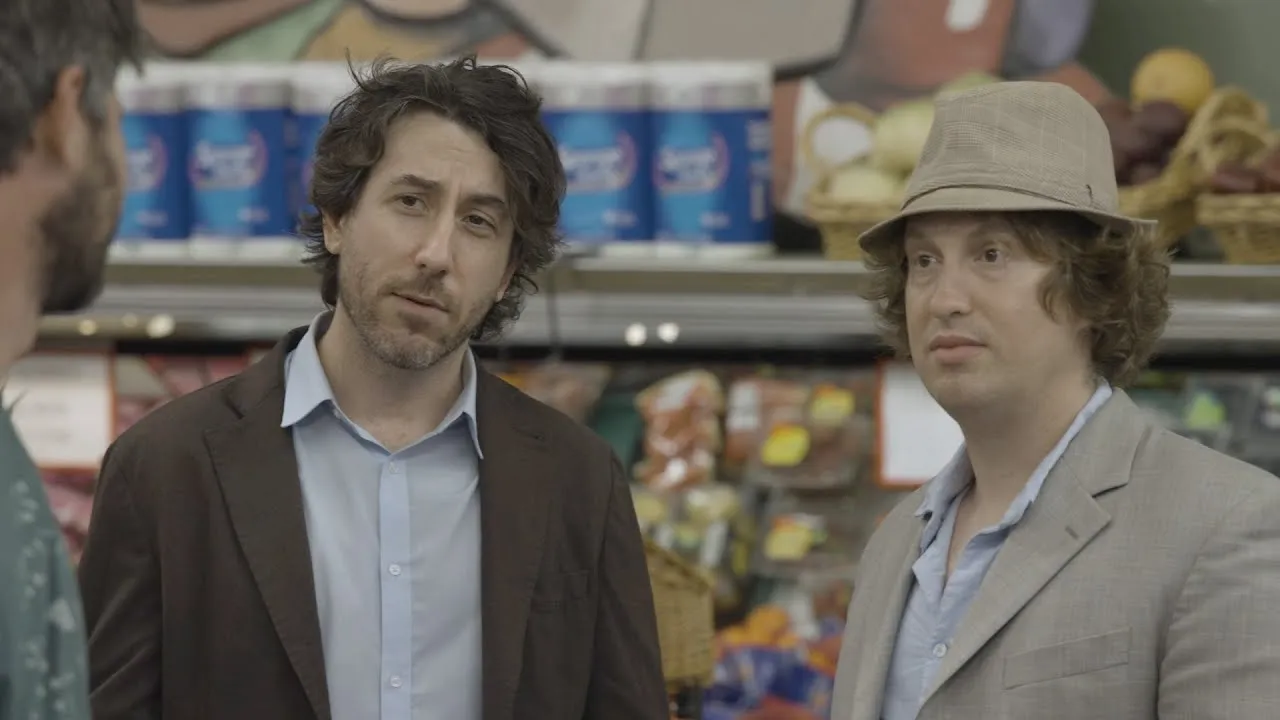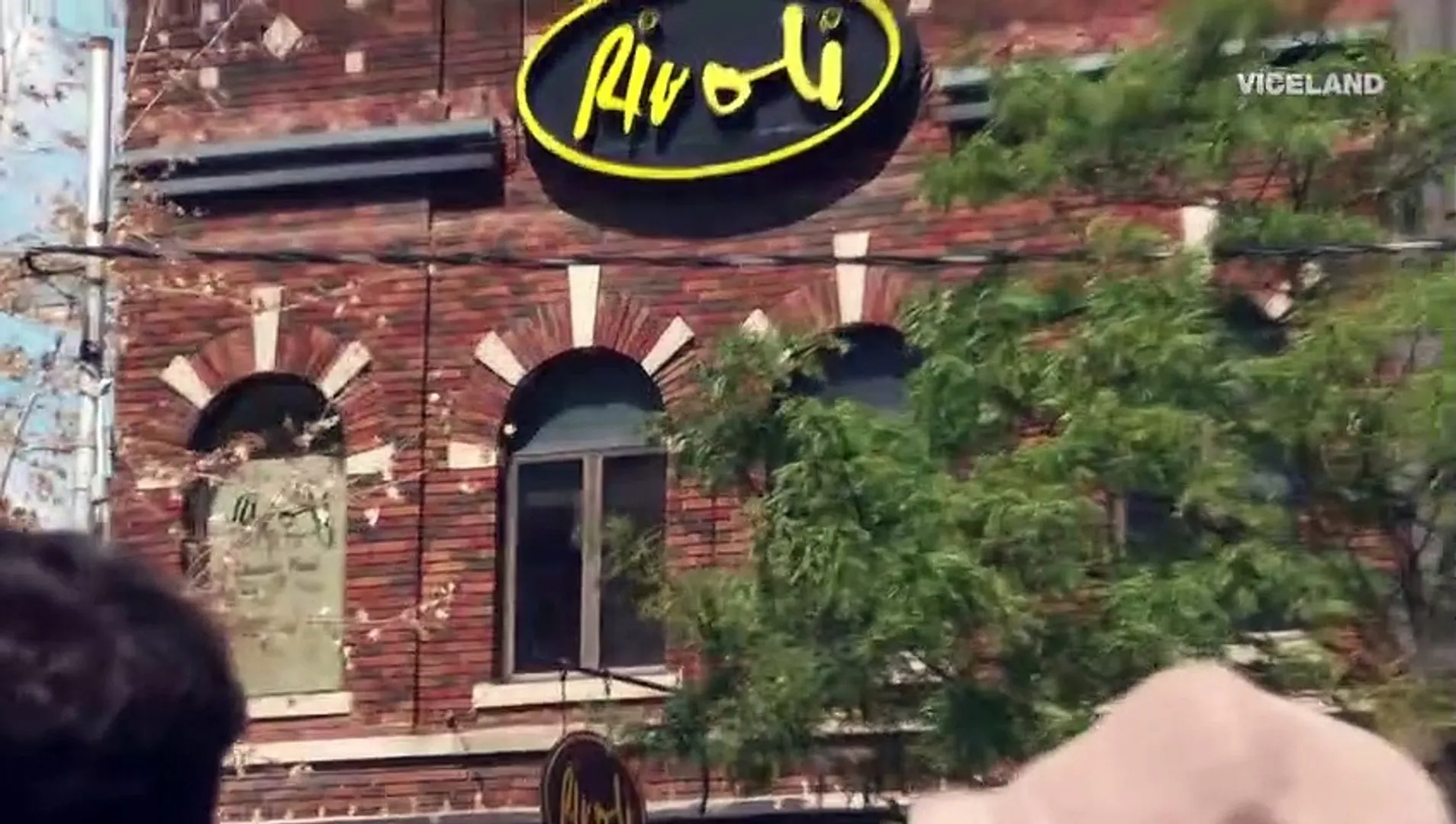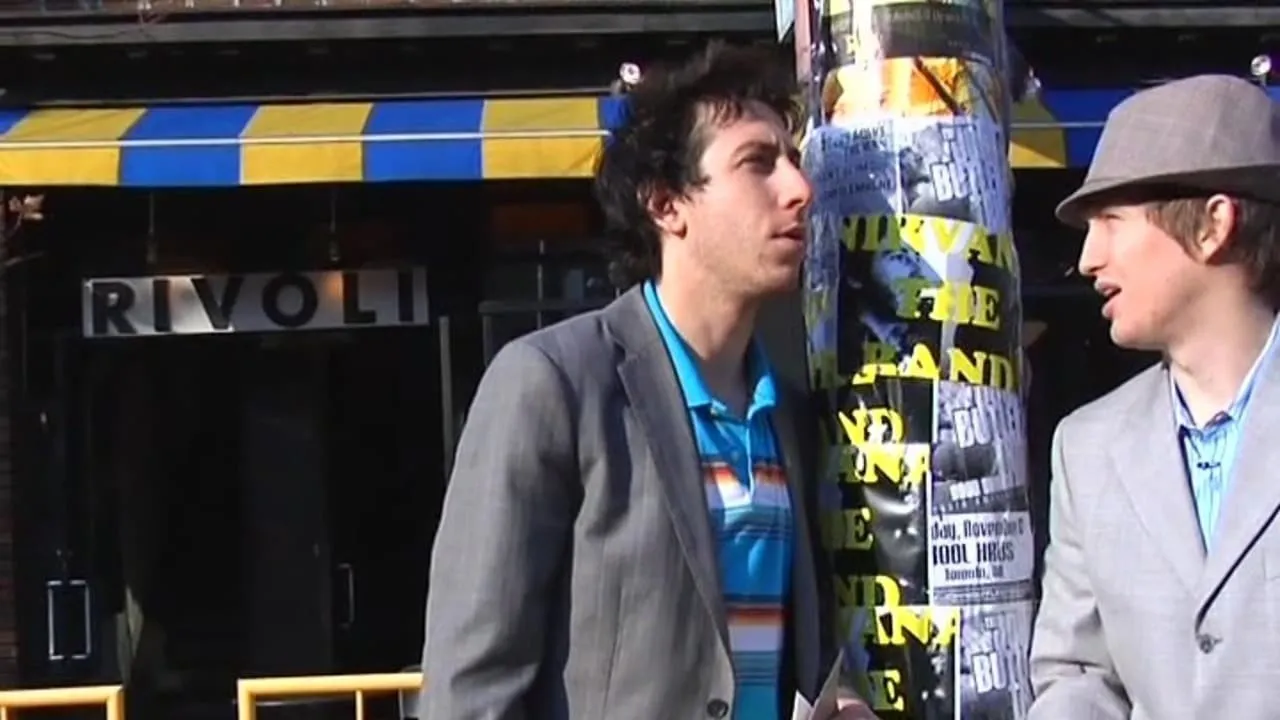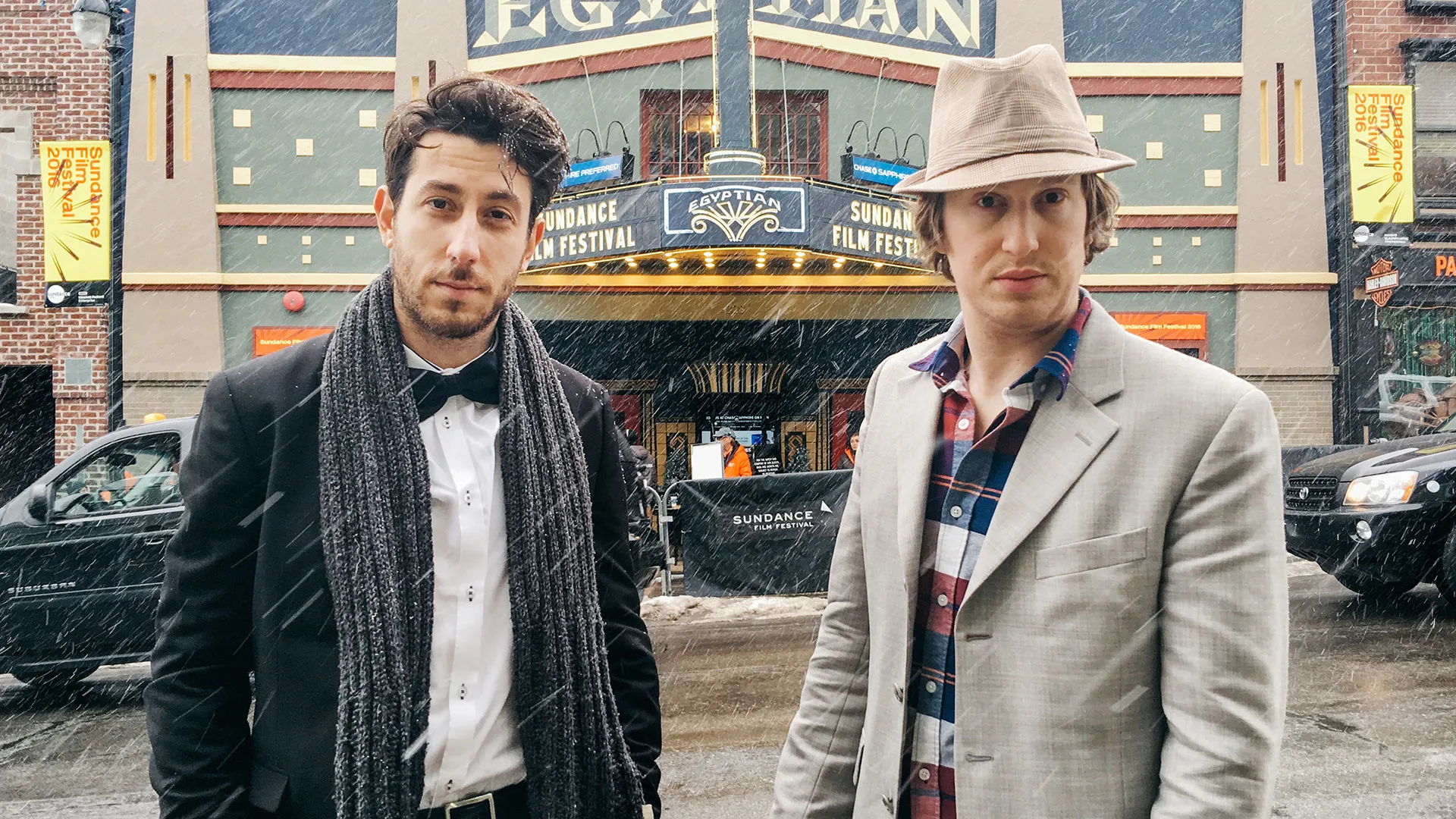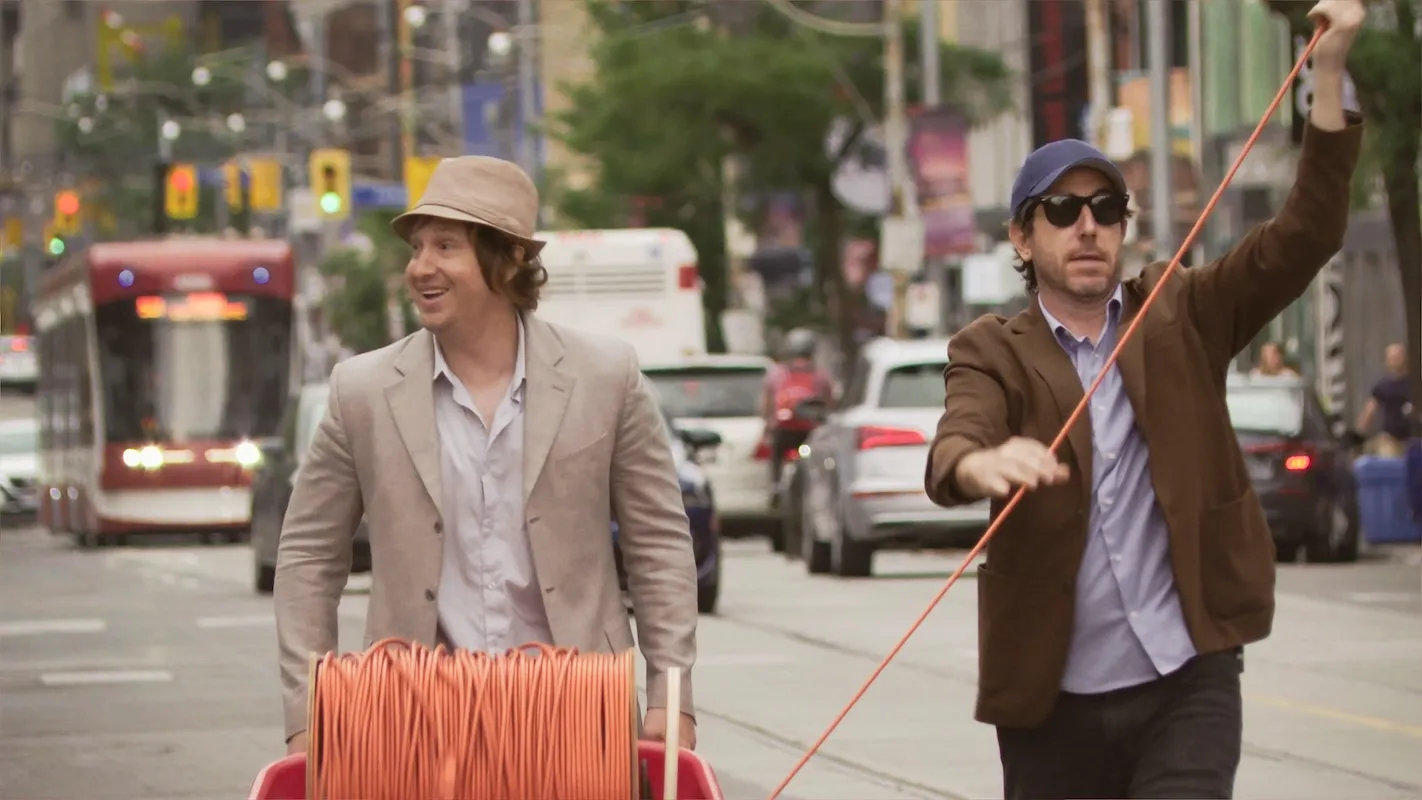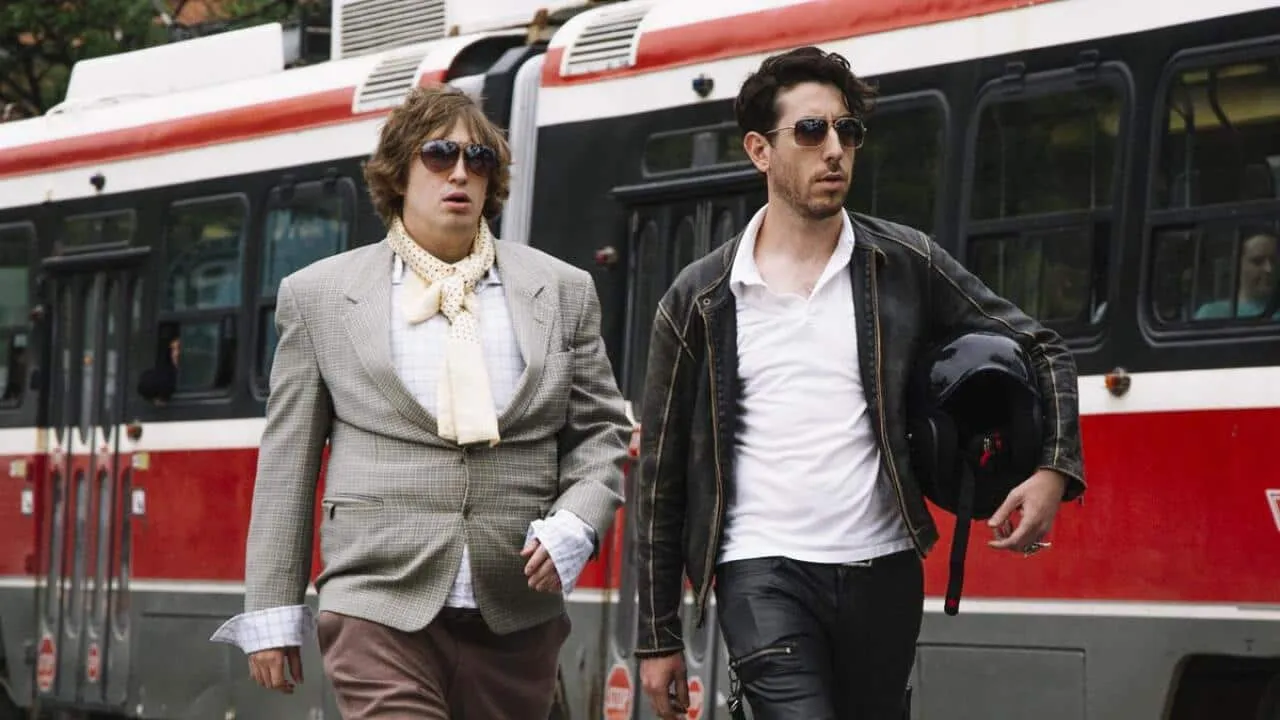From the moment the camera trails Matt and Jay across Toronto’s streets, Nirvanna the Band the Show the Movie establishes a playful tension between spontaneous prank and narrative precision. We meet two friends bound by a single obsession—to secure a gig at the Rivoli—yet within minutes their world erupts into homemade time machines and accidental lightning strikes. It’s a clever pivot: what begins as a mockumentary sketch in search of real-world reactions evolves into a full-throttle homage to DIY science fiction.
That premise—two hopeless musicians stranded by their own schemes—serves as sturdy scaffolding for a story that folds back on itself. Johnson and McCarrol open with a low-stakes stunt (skydiving off the CN Tower) before ratcheting up the stakes when Jay contemplates a solo career. This shift doesn’t feel tacked on; it underlines the central conflict between camaraderie and ambition. The tonal fusion is seamless: guerrilla-style footage meets split-screen visual effects, each beat echoing classic time-travel narratives without resorting to pastiche.
Running just over 100 minutes, the film threads rapid-fire jokes into a coherent structure. It honors the irreverent spirit of the original web series while embracing cinematic techniques that heighten emotional impact. For anyone tracking the evolution of indie storytelling, this feature marks a milestone: an indie prank show transmuted into a narrative with genuine heart and mechanical precision, two decades in the making.
Tracing the Blueprint: From Web Series to Feature Film
The story of Nirvanna the Band the Show the Movie begins in a cramped Toronto apartment, circa 2007, where Matt Johnson and Jay McCarrol shot guerrilla-style sketches on a shoestring budget. Their core gambit was straightforward: two earnest underachievers staging outrageous pranks in public spaces, banking on the unpredictability of real-life reactions. Those early episodes operated like improvisational labs, testing how far they could push narrative integrity before reality snapped back.
A decade later, the pair secured a spot on Viceland, transforming their DIY experiment into a two-season television series. With brighter lights and slightly deeper pockets, they sharpened their mock-documentary format, though corporate entanglements soon stalled plans for a third installment. That hiatus exposed the tension between creative autonomy and network constraints—an obstacle many indie creators encounter when scaling up.
Enter Johnson’s breakout feature, BlackBerry, which earned enough goodwill to greenlight this long-gestating project. Freed from network gatekeepers, he reclaimed his original sandbox, expanding the scale without sacrificing the improvisational edge. Two decades after sketching their first harebrained scheme, Matt and Jay’s odyssey arrives onscreen as a cohesive narrative—one that preserves the raw spirit of their beginnings while embracing the demands of cinematic storytelling.
Narrative Mechanics: From Sky-High Schemes to Temporal Rescue
The film hooks you with its opening gambit: Matt and Jay leap from the CN Tower, aiming to parachute into a Blue Jays game at Rogers Centre. It’s an audacious inciting stunt—one part Looney Tunes, one part guerrilla filmmaking—that immediately raises stakes. When the roof snaps shut on their descent, that singular failure anchors the rest of the story, transforming a publicity stunt into a fracture in their partnership.
This misstep triggers Jay’s moment of doubt. As he voices a desire to strike out solo, the screenplay exploits that fissure with precision, turning a gag into genuine emotional turbulence. The tension between Jay’s pragmatism and Matt’s boundless enthusiasm propels the second act, giving their friendship a pulse beyond punchlines.
Enter the RV time machine: a hodgepodge of wires, a dusty bottle of Orbitz, and a lightning strike. The film lays out its temporal rules clearly—miss the window, and your reality splinters. It’s reassuringly logical for a movie this playful, avoiding paradox traps by tethering every jump to a physical trigger.
Transported to 2008, the pair navigate a series of low-budget heists: sneaking through their former apartment, raiding alt-weekly offices, even ducking into the Royal Ontario Museum. Each location serves dual purposes—plot necessity and character reflection—highlighting how far they’ve come, and why returning matters. The fetching of another Orbitz bottle becomes an ingenious quest item, reminiscent of video-game fetch missions yet grounded in genuine stakes.
Finally, the film circles back to its opening premise. A second lightning strike restores their original timeline, but not before forcing both men to confront what really holds them together. In those final minutes, the structure—bookended by skydiving and time travel—feels tight. Every stunt, misfire, and reconciliation beats with narrative purpose, ensuring that the mechanics of comedy never outpace the heart at the center.
Character Dynamics and Authenticity
Matt emerges as a force of nature: equal parts bravado and blissful unawareness. His schemes crackle with energy—the CN Tower skydive, the RV time machine—yet his greatest asset is a knack for spilling every secret plan to unsuspecting bystanders. When he glances at the camera to warn of a “copyright nightmare,” that fourth-wall wink underlines his confidence and the film’s playful self-awareness.
Jay serves as the emotional ballast. His cautious realism braces against Matt’s wild ideas. Early on, Jay hesitates at the thought of endless stunts; by the midpoint, his solo-career temptation carries genuine weight. The performance charts a convincing shift from sidekick to potential star, without ever undermining their bond. It’s a quieter arc but one that gives the narrative its necessary emotional counterpoint.
The supporting cast doubles as both characters and collaborators. Cinematographer Jared Raab steps into view, blurring the line between crew and participant. Then there are the everyday Torontonians—a Canadian Tire clerk whose laissez-faire Libertarianism fuels a joke, a TTC guard baffled by two pranksters—whose spontaneous reactions inject unpredictable humor. Each cameo reinforces the film’s strategy of letting real life puncture scripted beats.
Underpinning every interaction is a chemistry honed over twenty years. Johnson and McCarrol move with a familiarity that turns improvised gags into essential character moments. Their banter never feels tacked on; it feels earned. Watching them riff off genuine reactions, you sense that each laugh springs from a place of trust—between performers, and between the film and its audience.
Stylistic Framework and Technical Execution
From the opening credits, the film wears its mockumentary roots on its sleeve, charging through Toronto streets with hidden cameras and minimal permits. Shots dart between alleyways and landmarks, capturing unfiltered reactions to every harebrained scheme. This guerrilla approach grounds even the most fantastical moments—when Matt and Jay sketch out time-travel equations atop their RV, you still feel the whirr of a streetcar in the background.
The editing operates at breakneck speed. Gags arrive in bursts, Easter eggs flicker past in milliseconds, and the split-screen effects fuse 2008 and 2025 in a single frame. A single cut can bind two eras, two moods, and two punchlines without missing a beat. It might feel dizzying, but that vertigo is precisely the point: the film refuses to linger on any moment too long.
Visual effects lean into resourceful charm. Elaborate split screens and lightning strikes echo Robert Zemeckis’s handiwork, yet they’re executed with thriftier tools. A battered bottle of Orbitz becomes a narrative linchpin, its period-accurate label juxtaposed with modern graffiti in one seamless shot. The production design layers props from different decades—old alt-weekly posters, vintage band flyers—offering texture without ever screaming “set dressing.”
On the audio side, the score taps Alan Silvestri’s heroic flourishes, cueing you to expect grand spectacle even as you laugh. Those orchestral swells collide with diegetic piano riffs and the occasional chord progression labeled “Nirvanna original.” It’s a playful collision of epic and mundane. Those shifts in volume and style reinforce both the emotional beats and the absurd stunts, ensuring that when the RV sparks to life, you feel the electricity in your seat.
Thematic Layers and Wit
At its core, the film turns the Rivoli obsession into a comedic McGuffin: a single goal that propels every scheme, stunt, and detour. That fixation lampoons the “good-enough” Canadian ethos, where modest aspirations often collide with boundless creativity. Matt and Jay’s relentless drive to book a gig becomes an amusing microcosm of ambition unmoored from practicality—yet each failed attempt deepens our understanding of why they chase this particular dream.
Beneath the slapstick lies a sincere portrait of friendship under strain. Jay’s flirtation with a solo career forces both characters to reckon with loyalty versus self-fulfillment. Their heated exchanges in the RV feel unvarnished, not scripted: Matt’s hurt pride and Jay’s guilt over betrayal add genuine emotion to otherwise absurd situations. Those moments of tension give the film a sentimental tug, reminding us that these aren’t caricatures but collaborators whose bond matters more than any punchline.
The movie indulges in meta-commentary, tipping its hat to Back to the Future while nodding to Primer and The Butterfly Effect. Fourth-wall asides—most notably Matt warning about legal fallout—highlight the tension between mockumentary ethics and narrative invention. It’s a playful nod to the hidden-camera tradition, poking fun at the very idea of sneaking absurdity past unwitting participants.
Toronto itself takes on character status, as civic institutions—from police briefings to TTC stations—become playgrounds for prankish reinvention. Each location carries a dual purpose: advancing the plot and spotlighting the city’s textures. These shifting backdrops underscore how setting can amplify both chaos and charm.
Finally, the humor oscillates between physical slapstick and sly situational irony. A hardware-store gag lands with belly-ache laughter, while split-second Easter eggs reward repeat viewings. By blending unrehearsed spontaneity with tightly scripted set-pieces, the film sustains its momentum and keeps its wit sharp.
Final Impact and Legacy
The film’s greatest asset is its unrelenting energy. From the first guerrilla-style stunt to the last lightning-fueled reset, it sustains a manic momentum that never feels forced. Its comedy remains inventive, blending hidden-camera authenticity with meticulously crafted visual tricks. At the same time, the underlying friendship between Matt and Jay provides an emotional anchor—proof that heart can coexist with high-concept absurdity.
In today’s landscape, few indie comedies dare to tackle both guerrilla filmmaking and time-travel homage. This movie breaks that mold, proving there’s still room for small-scale productions to take big creative swings on the big screen. Its success could encourage other storytellers to revisit DIY roots without sacrificing narrative ambition.
By signaling a third season on the horizon, it honors its origins while charting a path forward. Even newcomers will find enough laughs and narrative clarity to stay engaged. Whether or not it’s the funniest Canadian comedy in a generation, it sets a new bar for what indie satire can achieve.
Full Credits
Director: Matt Johnson
Writers: Matt Johnson, Jay McCarrol
Producers: Matthew Miller, Matt Greyson
Executive Producers: Jay McCarrol, Jared Raab
Cast: Matt Johnson, Jay McCarrol, Jared Raab, Ben Petrie, Ethan Eng, Luke Lalonde
Director of Photography (Cinematographer): Jared Raab
Editors: Curt Lobb, Robert Upchurch
Composer: Jay McCarrol
The Review
Nirvanna the Band the Show the Movie
In my view, Nirvanna the Band the Show the Movie delivers relentless energy, sharp laughs, and a surprisingly tender friendship at its core. It stands out as a daring indie comedy that balances guerrilla-style invention with genuine heart.
PROS
- High-octane pacing keeps laughs coming nonstop
- Clever integration of hidden-camera stunts and scripted beats
- Heartfelt chemistry between Matt and Jay
- Resourceful effects that honor classic time-travel tropes
- Toronto setting feels alive and characterful
CONS
- Rapid-fire jokes may overwhelm on first viewing
- Occasional tonal whiplash between slapstick and sincere moments
- Some Easter eggs vanish too quickly to catch
- Minor dips in focus when shifting eras
- Limited original music beyond homage cues









































